Victoria Line: The Lifeline of London’s Underground Network

Introduction
The Victoria Line, a crucial component of the London Underground, serves over 200,000 passengers daily. Connecting major hubs and facilitating transport across the capital, its importance has only grown, especially amid the increasing demand for efficient urban travel. Recent upgrades and expansions are aimed at improving service and accessibility, making the Victoria Line a focal point in London’s public transport developments.
History and Significance
Opened in 1968, the Victoria Line was the first fully automatic line on the London Underground. Spanning 13 miles from Walthamstow in the northeast to Brixton in the south, it intertwines with several other lines, enhancing connectivity within the city. Its establishment was a response to the growing population and demand for reliable transport, providing quick links to major centres such as Victoria Station and Oxford Circus.
Recent Developments
In recent years, Transport for London (TfL) has invested heavily in improving the Victoria Line. As part of its modernisation programme, new trains have been introduced, enhancing performance and passenger experience. These upgrades include increased frequency, which has reduced waiting times significantly, and real-time information systems that keep passengers informed of any service disruptions. The introduction of step-free access at several stations is also noteworthy, making travel more accessible for individuals with reduced mobility.
Challenges and Future Outlook
Despite improvements, the Victoria Line faces challenges such as overcrowding, especially during peak hours. With London’s population expected to rise, TfL is exploring options to enhance capacity further. Future projects may include additional train services and infrastructure upgrades, designed to accommodate the anticipated increase in passenger numbers.
Conclusion
The Victoria Line continues to be a vital artery of London’s transport system, contributing to economic growth and urban mobility. As developments unfold, its role in managing the city’s transport needs will be critical. For residents and visitors alike, understanding the importance of this line marks an appreciation of not just a transportation route, but a lifeline that binds the community together.
